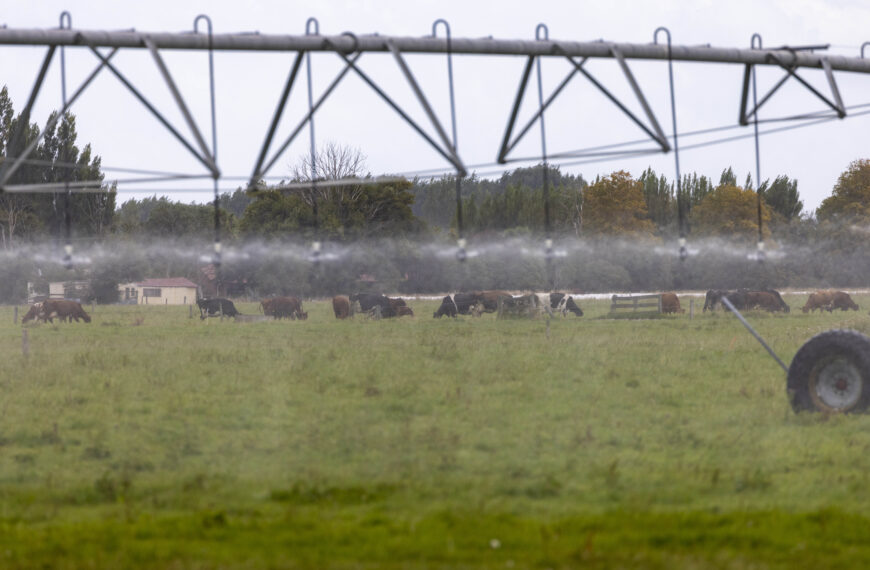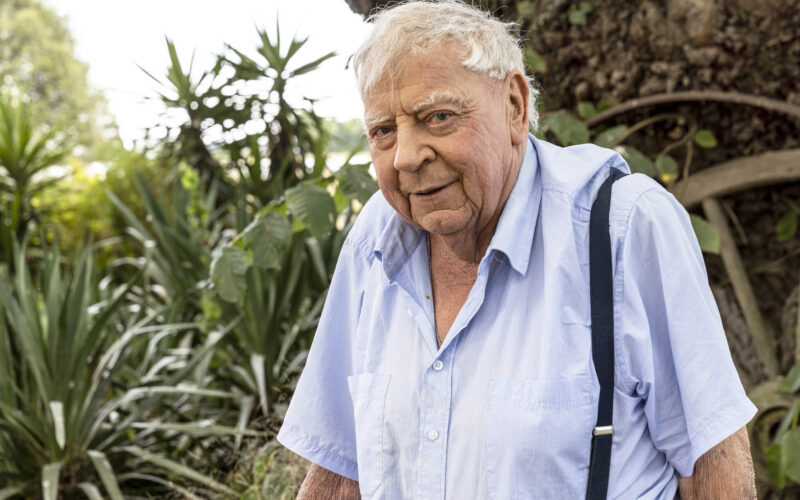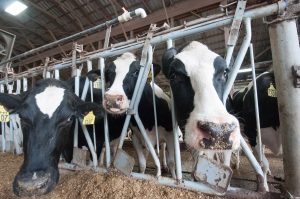
A veteran Canterbury farmer has always been happy to do things a bit differently, whether it be his affection for Milking Shorthorns, his hybrid barn and pasture system, or replacing conventional fertilisers with effluent, but he’s succeeded in his goal of high production, as well as leaving his land in a much better state than when he started out.
Phil Garrett bought Rushbrook Farm at Leeston, south of Christchurch, near Lake Ellesmere/Te Waihora, in 1986 and has farmed it since then with his son Andrew. Originally 103ha, the property has now grown to 440ha and milks 1000 cows, but with young stock usually carries 1750 cattle.
Now nearly 84, Garrett has loved cows since he was a toddler and always wanted to be a farmer, a goal he achieved through hard work, not inheritance.
His parents had a farm in western Southland but when he was two, in 1941, his father died.
“There were five of us and then my younger sister was born six weeks after he died and we ended up coming to Christchurch because Mum’s father lived up here and had a tailoring business and he bought a little five acre [2ha] block in Heathcote [on the city’s outskirts]. We lived there from about 1942,” Garrett recalls.
The neighbours had a small dairy farm.
“When I was about four years old I used to hop through the neighbours’ fence and help milk the cows, put the cups on, and I’ve always been associated with cows ever since.”

When he left school at 15, Garrett took a job on the neighbour’s farm and stayed for seven years but he realised he’d never make enough money as a farm worker to get a farm of his own so he found a job with a malting company. That paid better but still not quite enough.
“For two years I also worked night shift at the Empire roller mill from 4pm till midnight and that got me the money for my little nest egg to get going, to buy the first piece of land.”
He went into partnership with a friend to buy the farm where he’d previously worked and they ran it together, though Garrett also traded sheep and cattle through the old Addington saleyards to boost his income.
“At one point we had the highest turnover of any client in Canterbury with Wrightson NMA [a predecessor of PGG Wrightson].”
In 1986, after 12 years, they split the farm partnership when his friend wanted to get married. They each took half the land and his friend built a house on his piece while Garrett sold his half and bought a 103ha sheep and cropping farm at Leeston, south of Christchurch, near Lake Ellesmere/Te Waihora.
It was among the first farms in the district to be converted to dairy farming.
“We had to build the dairy in a muddy paddock and it was raining and it was a struggle to get it built.”
He took over on July 1, 1986, and arrived there with one of his sons and a daughter (he was by now divorced) on July 5. On September 19, the shed was finished and ready for the first milking.
“The cows were still being milked in Heathcote until then but we had to get out of there because we’d sold it.”
The 119 mostly Milking Shorthorn cows had never seen a herringbone shed, having previously been milked in a walk-through.
“The first milking in a strange shed was exciting. They had to learn to line up and they wondered what the hell we were doing to them. It was harder than training heifers because they were cows and more used to their ways. But we got there and after the first couple of days it wasn’t so bad.”
The herringbone had 30 bails and about 15 years ago another 25 bails were added alongside, to make a twin herringbone.
“It works well and we milk 1000 cows through it. It takes a while but we get there. Ideally we’d have a new shed but the only place to put it sensibly is where the existing one is and that creates difficulties – and a new shed is roughly $3 million so you think twice about doing it.”

For most of the year about 1000 cows are milked though that varies during the year – in early February it dropped to 800 in milk but with 400 cows due to calve that will increase. Approximately 25 animals are culled each month, a total of 250 annually.
Production is around 575,000kg MS, something Garrett is keen to build on, as he has year by year since he came to the farm.
“I know it could be better. Papers like yours have reported about other farmers doing 700kg; well, I reckon we’re capable of doing that if they’re looked after and fed, that’s all that has to happen, because we’re doing close to 600kg now.”
At the same time as the shed was being built in 1986, new fences had to go up, a task made challenging by the fact they didn’t have a tractor on the farm because it was still at the old place being used for feeding out.
“It was wet and we wheelbarrowed posts to the far end of the paddock and dug them in by hand. It was that wet we had a small hand driver we could use too. It was interesting,” Garrett says.
One of the things that attracted him to the farm was the availability of well water for irrigation, even though there was no irrigation in place when they arrived. In the second year they put in a gun and over the years have improved the irrigation on the now 400ha property, which now has six centre pivots plus some K-Line and a RotoRainer for the corners.
Being very close to Te Waihora, the farm has a high water table, especially when lake levels get high. That means it gets very muddy easily, and that used to make farming challenging, to say the least.
“We were just sick of it and my son Andrew said one day, ‘We need to build a pad or something,’” he says.
“He rang a Dutch fella who was building a pad, and he told him ‘You don’t need a pad, you need a shed,’ so we got talking about it and I’d seen them overseas and I knew how they worked. I thought, ‘This is alright’.”
They talked about building a shed to house 500 cows but by then they were already milking 900, so Garrett said, “No, I’d rather house them all or we don’t do it.”

The big shed they built has 897 stalls and can safely hold 1000 cows, or up to 1200 for two or three days if there’s a snowstorm or similar weather event.
“We have had to do that at times and put dry stock in as well to keep them off the pasture.”
The shed has made a massive difference to the farm, Garrett says, and in the 10 years since it was built, production has virtually doubled. In that time the area the cows graze has been reduced from 280ha to 160ha and production is still improving.
“We have one herd in at night and they graze outside during the day and the other herd comes in during the day and grazes outside during the night,” he explains.
That changes for the six or seven weeks of mid-winter when the cows are only allowed out if the ground is dry enough and the sun is shining.
“Andrew’s got it working pretty well, as well as the grazing management. You’ve got to manipulate their grass so you can feed them and you’ve got to manipulate the barn. You have to watch that the cows have cleaned up everything in the barn and if they haven’t cleaned it up, they’ve obviously got plenty of grass out in the paddock.”
The cows are very well fed in the shed.

“We’re very high input, no question about that and we buy a lot of feed in. We use about 5000 Freeman bales of silage a year and we have some chopped as well and we’ve got our own maize silage on top of that.
“Then we have brewers grains come in and we have about two truck and trailer loads a week from Watties from the vegetable waste – we’re their best friends because we take it all the time.”
The other key to making the system work is pasture management, only feeding grass that’s short and sweet and topping if it gets too tall or making silage it gets taller still.
“We’re on a 10-day grazing round, which will startle a lot of people,” Garrett says.
That’s made possible in part by using effluent from both the barn and cowshed as what Garrett prefers to call “organic fertiliser”. They use virtually no other fertiliser on the farm but every year spread about 32 million litres of effluent over the whole property, drawn from the 12 million litre storage pond next to the barn.
“The pastures have improved so much in the last 10 years without any fertiliser, just effluent, it’s absolutely astounding and we haven’t put any new grass in – they’re all old pastures with dandelions and God knows what – they grow like fury.”

The organic fertiliser is also used on the 85ha of maize grown on the farm every year, along with a small amount of nitrogen added at sowing, the only additional fertiliser used.
“That will be chopped for silage at the end of March. We made about 17t a hectare last year, which is not bad for Canterbury. We’ve had it one paddock for 10 years in a row and it’s getting better.”
Four to five tonnes of lime flour is used in the shed every week to keep the bugs at bay and that finds its way onto the pasture too, in the effluent.
“So that lime’s going out on the farm all the time, helping to balance things up – and even lime’s got a bit of phosphate in it.”
Ashburton contractor Matt Lovett spreads the effluent with a tanker that lays the slurry at the base of the plant and is on farm every 10 days to a fortnight. Before he arrives, two big stirrers go to work in the pond. The 28,000 litre tanker can spread up to a million litres a day.
“We’ve taught a lot of other people how to use their effluent,” Garrett says.
“When they first started coming here, they were going to other places where they were told, ‘Dump it all in that paddock there’, but Matt told them we were spreading it over the whole farm and now he’s doing that on a hell of a lot of farms and they’re saving the fertiliser bill.”
In his nearly 37 years on Rushbrook Farm, Garrett has seen a huge improvement in its pasture and soils, something he puts down to the cows as well as the effective use of effluent. He tells the story of the second block he bought, which had previously been cropped for close to 50 years with nothing put back.
“It was in grass when we took it on and we just shut the gate and left it and thought there’d be enough feed there for winter for the cows but nothing grew for 12 months until we started to water it. It had rain but it just wouldn’t grow, it was just dead, completely robbed and now with cows being on it and the effluent going on, it’s one of the best blocks on the farm.”
Another unusual thing about the farm is the breed of cows, which is quite different from the Friesians or Kiwi cross found on most New Zealand dairy farms. Garrett has liked Milking Shorthorns since he was a child and that breed still forms the basis of the herd but with other breeds too and many different crosses, including Friesian, Jersey, Guernsey, Brown Swiss, Fleckvieh, Montbéliarde and Speckle Park.
“It’s me who’s done it and as a business you wouldn’t do what we’ve done with the different breeds but to my way of thinking there’s not a lot of difference between any of the breeds. If you feed them properly, you’ll get similar results from all the breeds.”
While breeds like Friesians might produce higher volumes, other breeds make up for that with higher solids or protein, he argues.
“We’ve sort of focused on milksolids over the years and picked the bulls from cows that have over 4% protein. We still milk a few wishy-washy Friesians that are down in 3% of protein but they have a lot of milk so they help balance things up I suppose.”

A life member of the NZ Milking Shorthorn Association, Garrett is still winning most of its production awards, for highest milked and highest protein cows. He can recite the pedigree of the about 1750 animals on the farm, including young stock.
Sitting at the kitchen table, he spies a red-and-white bull calf grazing outside.
“His mother is one of the top breeding cows in the country with 760kg of milk solids. We have others that do that too.”
Garrett selects bulls from around the world, including Sweden and Norway, mainly red animals but also some Friesians, preferring Scandinavian semen to American because he believes breeders there adhere to higher standards.
“We’ve got some really good Friesians but they’re only as good as our good red ones, they’re not any better.
“When I was in Heathcote I thought wouldn’t it be great to have 200 cows to breed from. Well, now I have 1000 to breed from. It makes a big difference, the selection process is better. They’re all recorded and you can look them up on MINDA.”
He’s moving all the breeds towards polled, something he picked up from the first farmer he worked for who put a polled beef shorthorn bull over his Milking Shorthorn cows.
“Some of the calves were awful beefy things. That was in 1946, and I was only a kid but I can still see the bull in my mind’s eye now. It came from Winchester, and I’ve still got descendants of those animals. I’ve just carried on, that’s all.”
He’s following the worldwide movement to get rid of the horns by breeding, believing it’s just too much hassle removing them. About two thirds of the herd are polled and nearly all the calves born are polled too, thanks to the selection of solely poll bulls.
Breeding on Rushbrook is very different to most farms, to fit in with year-round milking, with 50-80 cows calved in February/ March from 42 days of AI, and another 100 calved in June to beef bulls. During this time, they also calve spring-born heifers at 22 months.

The remainder of the herd calve in spring, the result of a 42-day mating period, and then over 28 days in November/December, the straggler heifers, which have been mated to beef bulls, are calved.
“Over the last 18 months we’ve seen a dramatic increase in heifer weights as a result of my grandson Ethan becoming chief calf rearer and managing all young stock,” Garrett says proudly.
All calves born are reared and ready markets have been established for the beef breeds as well as the Friesian bull calves.
But it’s not just production and breeding that drives Garrett. He’s a strong believer in looking after the land and has won various awards for riparian planting and looking after the stream that flows through the farm on the way to Te Waihora.
“We’ve got a lot of drains planted with carex, lots of flax. The farm’s different to other farms, we’ve got a different outlook. You should leave the land better than you found it and we’re certainly going to do that here.”

After 37 years on the farm, he is pleased with what he’s achieved but doesn’t pretend he’s done it himself, crediting his publicity-shy son Andrew and grandson Ethan for much of it.
“Andrew was the driving force behind the barn 11 years ago and has also overseen big changes to the irrigation system.”
Andrew is soon to retire from active farming for health and family reasons and Ethan plans to move on soon, too. Poor health has also forced Phil to take a step back and an operations manager has been appointed to continue the work he and his son have started.

























